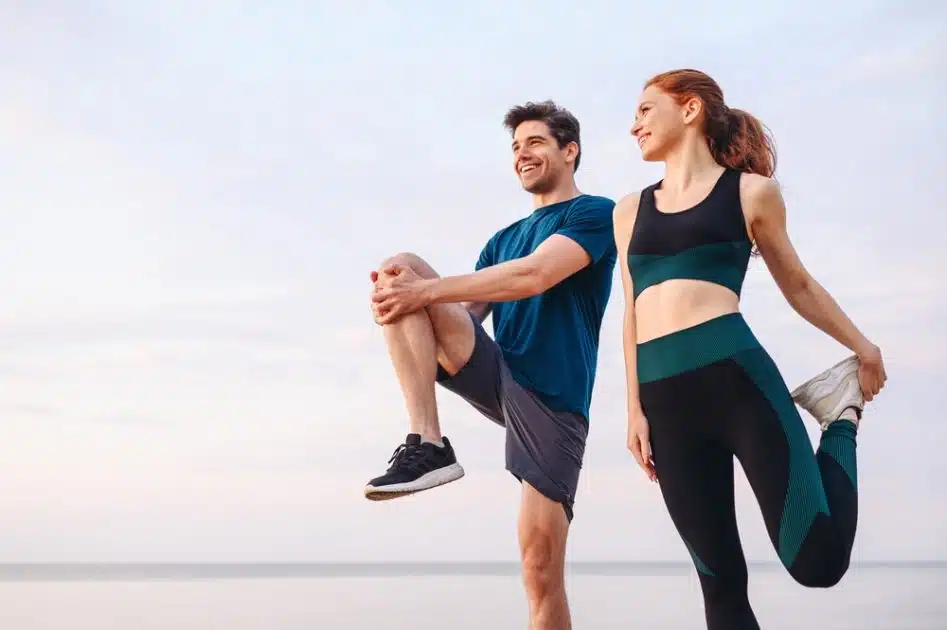Exercise is a physical activity that involves moving the body, increasing the heart rate, and exerting the body beyond its resting state. Engaging in regular exercise is crucial for maintaining overall health and preventing various diseases.
Exercise comes in many forms, and can be broadly categorized into four main types: aerobic, balance, flexibility, and strength. Each type targets different aspects of physical fitness and contributes to overall well-being.

Unfortunately, there are many common myths surrounding exercise, often promoted by those looking to sell “get fit quick” schemes or products. These myths can mislead people and create confusion about the best practices for achieving optimal health and fitness.
It is essential to debunk these misconceptions and provide accurate information to ensure that individuals can make informed decisions about their exercise routines and habits.
Myths About Exercise
Myths about exercise are often perpetuated by those promoting “get fit quick” schemes, which capitalize on people’s desire for quick results with minimal effort.
One common myth is that working out in the morning significantly impacts metabolism; however, research has shown that the time of day has little effect on exercise-induced metabolic changes.
Another prevalent myth is that cardio is more effective than strength training for fat loss. In reality, combining both types of exercise can lead to optimal fat loss since increased muscle mass can boost resting metabolic rate, aiding in calorie burning throughout the day.
Lastly, the notion of a secret formula for fitness and health is misleading, as the key to success lies in consistent effort and a balanced approach to exercise and nutrition.
By debunking these myths with evidence from reliable sources and scientific studies, individuals can make informed decisions and develop effective, sustainable fitness routines.
Diverse Exercise Types
Embarking on a fitness journey can be both exciting and intimidating. With numerous exercise options available, it’s essential to understand the different types and how they contribute to overall health and well-being.
Let’s delve into the four main types of exercise, providing insights, examples, and facts to help you develop a well-rounded and inspiring fitness routine.
Aerobic Exercise
Aerobic exercise, also known as cardio, focuses on increasing heart rate and breathing, thereby improving cardiovascular and respiratory health. These exercises rely on oxygen to produce energy, leading to enhanced endurance and stamina.
Examples of aerobic activities:
- Walking
- Jogging
- Climbing
- Stair climbing
- Dancing
- Biking
- Gardening
- Swimming

Fun Fact: Engaging in at least 150 minutes of moderate-intensity aerobic activity per week can reduce the risk of heart disease by up to 30% (American Heart Association).
Strength Exercise
Strength exercises involve the use of resistance to challenge and build muscle mass, increase bone density, and improve overall strength. These exercises are essential for maintaining daily function and preventing age-related muscle loss.
Examples of strength activities:
- Weight lifting
- Resistance machines
- Calisthenics (bodyweight exercises)
- Resistance bands
Strength training can increase resting metabolic rate by up to 7%, helping you burn calories more efficiently.
Flexibility Exercise
Flexibility exercises aim to increase the range of motion in joints, allowing for easier movement and reduced risk of injury. These exercises focus on stretching muscles and connective tissues, contributing to overall mobility and posture.
Examples of flexibility activities:
- Stretching
- Yoga
Fun Fact: Flexibility exercises can also help relieve stress and promote relaxation, as they often incorporate deep breathing and mindfulness techniques.
Balance Exercise
Balance exercises help improve stability, coordination, and core strength. These exercises are particularly important as we age, as they can reduce the risk of falls and associated injuries.
Examples of balance activities:
- Walking in a straight line
- Tai Chi
- Single-leg stretches
Approximately 1 in 4 older adults experience a fall each year, making balance exercises crucial for reducing fall risk (CDC).
A well-rounded fitness routine incorporates a variety of exercise types, ensuring that all aspects of physical health are addressed.
By engaging in diverse exercises, you’ll unlock your full fitness potential, promoting overall health, preventing imbalances or weaknesses, and reducing the risk of injury.
So go ahead, explore different exercises, and embrace the journey toward a healthier, more vibrant you!
Benefits of Exercise
As you embrace the journey toward a healthier, more vibrant you through diverse exercises, it’s essential to recognize the numerous benefits of regular exercise.
Engaging in consistent physical activity can significantly improve your quality of life and increase longevity. The advantages of exercise extend beyond the physical realm, encompassing mental and emotional well-being as well
Some specific benefits of exercise include:
- Weight control
- Reduced risk of heart disease
- Improved insulin levels
- Mood and stress relief
- Enhanced cognitive function
- Increased bone and muscle strength
- Reduced cancer risk
- Reduced risk of falls
- Better sleep
- Improved sexual health
Research supports these claims, showing that individuals who engage in regular exercise are more likely to enjoy a longer, healthier life. For example, studies have found that people who exercise for 150 minutes per week have a 33% lower risk of all-cause mortality compared to those who are inactive.
By understanding and appreciating the many benefits of exercise, you’ll be even more motivated to make it an integral part of your daily routine.
Exercise Recommendations
Understanding the recommended frequency and duration of exercise is crucial to achieving your fitness goals and reaping the benefits of a healthy lifestyle. Leading organizations such as the American Heart Association (AHA) and the World Health Organization (WHO) provide guidelines to help you develop an effective exercise routine.
Frequency and Duration
The AHA and WHO recommend that adults engage in at least 150 minutes of moderate-intensity aerobic exercise or 75 minutes of vigorous-intensity aerobic exercise per week, ideally spread across multiple days. Additionally, they suggest incorporating muscle-strengthening activities at least two days per week.
For even greater health benefits, the organizations encourage increasing moderate-intensity aerobic exercise to 300 minutes per week or vigorous-intensity aerobic exercise to 150 minutes per week.
Consistency and Progression
Maintaining consistency in your exercise routine is vital for long-term success. Establishing a regular workout schedule and sticking to it helps create positive habits and ensures that you continue to progress.
As your fitness level improves, gradually increase the intensity, duration, or frequency of your workouts to challenge your body and promote ongoing growth.
Personalizing Your Exercise Program
It’s essential to tailor your exercise program to your personal preferences, goals, and limitations. Consider factors such as your current fitness level, age, health conditions, and time constraints when developing a plan.
Choose activities that you enjoy and can commit to long-term. Be open to adjusting your routine as your needs and goals evolve.
Overcoming Barriers and Staying Motivated
It’s not uncommon to face barriers and challenges in your fitness journey. Here are some tips for overcoming obstacles and maintaining motivation:
- Set realistic goals: Establish attainable, specific, and measurable objectives that provide a clear path to success.
- Break it down: Break your larger goals into smaller, manageable milestones to make the process less daunting.
- Find a workout buddy: Having a workout partner can provide accountability, support, and camaraderie.
- Mix it up: Vary your workouts to prevent boredom and keep your routine fresh and engaging.
- Track your progress: Monitor your achievements to stay motivated and celebrate your successes.
- Focus on the benefits: Remind yourself of the numerous physical and mental health benefits of exercise to stay committed.
- Seek professional guidance: If you’re unsure about how to start or progress, consider consulting a personal trainer or fitness expert for advice.
By following these exercise recommendations and remaining adaptable and resilient, you’ll be well on your way to a healthier, happier, and more active lifestyle.
Adapting Exercise for Different Life Stages
Exercise plays a vital role in maintaining health and well-being throughout our lives. However, as we transition through different life stages, our exercise routines may need to be adapted to suit our unique circumstances, such as pregnancy, postpartum, older adulthood, or living with chronic conditions.
By understanding how to adjust our workouts during these phases, we can continue to reap the benefits of physical activity and embrace our journey with confidence.
1. Pregnancy
Regular exercise during pregnancy offers numerous benefits, including reduced discomfort, improved mood, and better preparation for labor and delivery. Aim for low-impact activities, such as swimming, prenatal yoga, or brisk walking.
Remember to consult with your healthcare provider before starting or continuing an exercise program during pregnancy, and always listen to your body’s signals.
2. Postpartum
Postpartum exercise can help new mothers regain strength, improve their mood, and support recovery. Begin with gentle activities, such as pelvic floor exercises and short walks, gradually increasing intensity as your body heals.
It’s essential to receive clearance from your healthcare provider before resuming more vigorous activities or starting a new exercise routine.
3. Older Adults
As we age, our bodies experience natural changes, making it essential to adapt our exercise routines accordingly. Focus on low-impact activities that promote balance, flexibility, and functional strength, such as tai chi, yoga, or resistance training.
Engaging in regular physical activity can help older adults maintain independence, improve cognitive function, and reduce the risk of age-related health issues.
4. Chronic Conditions
Living with a chronic condition doesn’t mean you can’t benefit from regular exercise. In fact, physical activity can play a critical role in managing symptoms, improving mobility, and enhancing quality of life.
Consult with your healthcare provider to determine the most suitable exercise program for your specific condition, and start with gentle, low-impact activities that can be easily modified as needed.
Adapting your exercise routine to suit your life stage ensures that you continue to benefit from physical activity while honoring your body’s unique needs.
Embrace each phase of your journey with an inspiring and compassionate approach, and remember that exercise is a lifelong commitment to health and well-being. By staying active and adaptable, you’ll be able to confidently navigate the challenges and joys of every stage in life.
Incorporating Rest and Recovery: The Key to Sustainable Progress
While regular exercise is crucial for maintaining a healthy lifestyle, it’s equally important to prioritize rest and recovery in your fitness journey.
Rest days, active recovery, and listening to your body all play vital roles in preventing overtraining and injuries, ensuring long-term success and progress in your fitness routine.
The Importance of Rest Days
Rest days are crucial for allowing your body to recuperate from the physical demands of exercise. During rest periods, your muscles repair and rebuild themselves, leading to increased strength and improved performance. Neglecting rest days can result in overtraining, which may lead to fatigue, decreased performance, and a higher risk of injuries.
Aim to include at least one or two rest days per week in your workout schedule to optimize recovery and maintain a healthy balance.
Active Recovery
In addition, to complete rest days, incorporating active recovery into your routine can further enhance the recovery process. Active recovery refers to low-intensity exercises or activities that promote blood circulation and help flush out metabolic waste from your muscles.
Examples of active recovery activities include gentle yoga, walking, swimming, or light stretching. Engaging in active recovery can help reduce muscle soreness, improve flexibility, and restore your energy levels, making it a valuable addition to your fitness regimen.
Listening to Your Body
Understanding and respecting your body’s signals is critical for preventing overtraining and injuries. Pay attention to signs of fatigue, excessive muscle soreness, or reduced performance, as these may indicate that your body requires additional rest.
Don’t hesitate to adjust your workout schedule or intensity based on your body’s needs. It’s essential to remember that recovery is an integral part of the process, and pushing through discomfort or pain can ultimately hinder your progress.
By incorporating rest and recovery into your fitness routine, you’ll be able to maintain a healthy balance between exercise and relaxation.
This balance not only supports sustainable progress but also reduces the risk of overtraining and injuries. So, give your body the rest it deserves and reap the rewards of a well-rounded and thoughtful approach to fitness.
Top 10 Iconic Fitness Programs
Over the last few decades, fitness programs and channels have become increasingly popular, with many people looking for ways to exercise conveniently at home. These programs offer a variety of workout styles, ranging from traditional aerobics and strength training to yoga, Pilates, and dance-based workouts.
Here are ten of the most iconic fitness programs and channels from the last few decades that have helped people achieve their fitness goals.
- Jane Fonda’s Workout – One of the earliest and most iconic home exercise videos, featuring aerobics and strength training routines.
- Insanity – A high-intensity interval training program by Shaun T, designed to push your limits and improve cardiovascular fitness.
- P90X – A 90-day program created by Tony Horton, featuring a mix of strength training, cardio, and flexibility exercises.
- Zumba Fitness – A dance-based workout program created by Beto Perez, incorporating Latin and international rhythms.
- Tae Bo – A mix of martial arts and cardio created by Billy Blanks, offering a high-energy workout.
- The 30-Day Shred – A program by Jillian Michaels, features three levels of high-intensity, circuit-based workouts.
- Yoga with Adriene – A YouTube channel led by Adriene Mishler, offering a variety of yoga classes and 30-day challenges.
- Beachbody on Demand – A streaming platform offering a wide range of fitness programs, such as 21 Day Fix, 80 Day Obsession, and Morning Meltdown 100.
- Blogilates – A YouTube channel by Cassey Ho, focusing on Pilates and bodyweight exercises, often set to popular music.
- 7-Minute Workout – A popular high-intensity circuit training workout developed by the Human Performance Institute, often used in apps and online videos.
The Bottom Line
Exercise is super important for staying healthy and feeling good overall. Let’s bust those exercise myths so we can make smart choices and build fitness habits that stick. Try different workouts like cardio, strength training, yoga, and balance exercises to mix things up and find what works best for you.
Remember all the awesome perks of regular exercise: managing weight, heart health, better mood, sharper mind, stronger muscles, and more. Let’s stay motivated, try new things, and find a routine that’s just right. Consistent exercise isn’t just good for your body, it boosts your whole quality of life. Keep moving, stay well, and enjoy the journey to a happier, healthier you!























